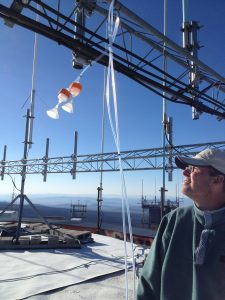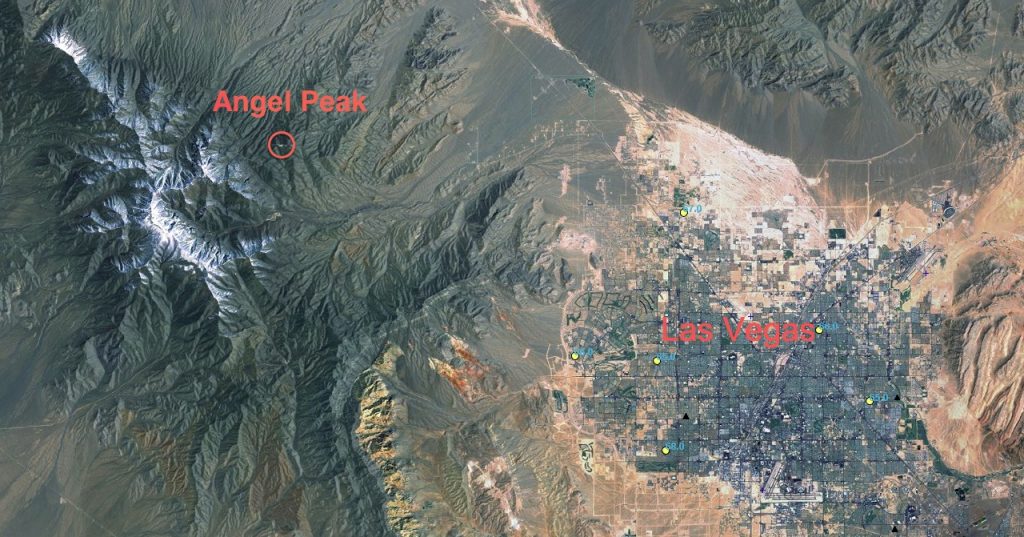25 January 2017
Weather patterns, trans-Pacific pollution cause spring ozone spikes in SW US
Posted by Lauren Lipuma

Christoph Senff, a NOAA-CIRES researcher, examines equipment used in NOAA’s Las Vegas Ozone Study (LVOS). New research from LVOS shows ozone transported down from the lower stratosphere can occasionally push some areas of the desert southwest above federal air quality standards.
Credit: Andrew Langford.
By Theo Stein
Late spring and early summer is when the air quality is generally good across most of the United States. But newly published research details how a common springtime weather pattern and pollution transported from Asia often conspire to create unhealthy ozone levels for the desert southwest.
Ozone in the stratosphere, located 10 to 48 kilometers (6 to 30 miles) above the ground, typically stays in the stratosphere. But not on some days in late spring when the polar jet stream meanders southward over the western U.S., bringing large cyclonic storm systems that cause stratospheric ozone to sink down into the troposphere closer to where people live.
The new study analyzed high ozone readings near Las Vegas, Nevada in May 2013, adding to a growing body of work that explores how ozone transported down from the lower stratosphere can occasionally push some areas of the desert southwest above federal air quality standards. The research, conducted as part of the Las Vegas Ozone Study (LVOS) at the request of the Clark County Department of Air Quality, was published today in the Journal of Geophysical Research: Atmospheres, a journal of the American Geophysical Union.
“These are examples of what we like to call good ozone going bad,” said Andrew Langford, a research chemist at NOAA in Boulder, Colorado and lead author of the new study. “‘Good’ ozone in the stratosphere protects us from the harmful ultraviolet rays of the sun, but ground level ozone can cause respiratory problems and crop damage.”
The U.S. Environmental Protection Agency’s proposal to tighten the federal standard for ozone from 75 parts per billion to 70 parts per billion for an eight-hour period has added urgency to the need to understand regional ozone sources and transport mechanisms. More than 50 metropolitan areas are designated as nonattainment areas for the 75 ppb standard, most because of high summer ozone levels.

A map showing Angel Peak, Nevada, where researchers analyzed high ozone readings in May 2013.
Credit: NOAA.
The new study focused on the week of May 19-26, 2013, when ozone concentrations in the Mojave Desert exceeded the federal standard on several days. Working from a site in the Spring Mountains, Langford’s team found that naturally occurring ozone that descended from the stratosphere can be captured by the exceptionally deep mixed layers of the lower atmosphere that form above the Mojave Desert, and brought down to the ground in areas like Las Vegas, Phoenix, and even Death Valley National Park.
Stratospheric intrusions can also bring pollution originating from Asia down to ground levels, though this contribution was usually much smaller. Combined, they added between 20 and 40 ppb of ozone to background levels, so the exceedances would not have occurred without their contribution.
The EPA’s “Exceptional Events Rule” allows states to exclude monitoring data affected by these intrusions, but most lack the resources to identify these events and quantify their impacts on surface ozone. NOAA plans to return to Clark County this spring to learn more about these processes and help these agencies and the EPA better understand these events.
—Theo Stein is a public affairs officer at NOAA in Boulder, Colorado. This post originally appeared on the NOAA website.


 GeoSpace is a blog on Earth and space science, managed by AGU’s Public Information staff. The blog features posts by AGU writers and guest contributors on all sorts of relevant science topics, but with a focus on new research and geo and space sciences-related stories that are currently in the news.
GeoSpace is a blog on Earth and space science, managed by AGU’s Public Information staff. The blog features posts by AGU writers and guest contributors on all sorts of relevant science topics, but with a focus on new research and geo and space sciences-related stories that are currently in the news.